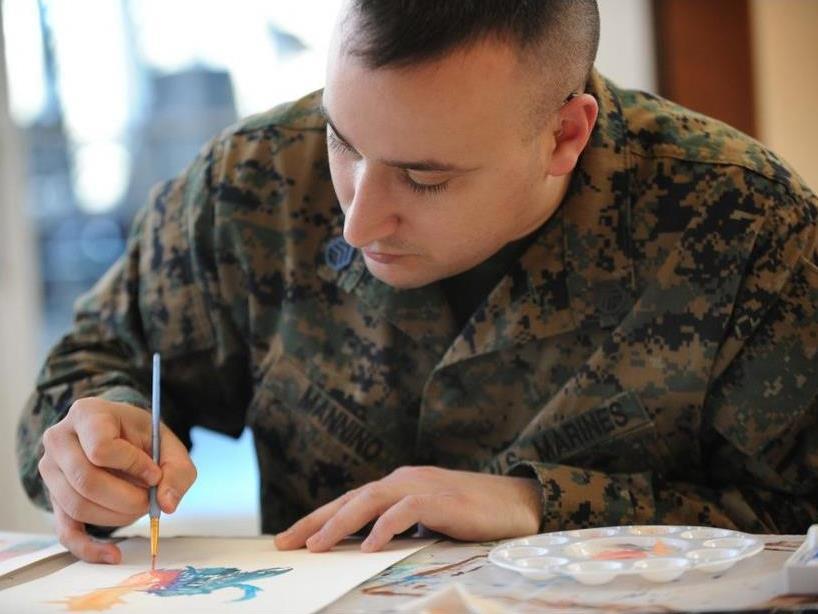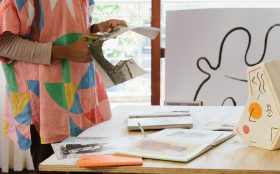Marine Staff Sgt Anthony Mannino uses art and music as part of therapeutic care for his traumatic brain injury. Marvin Lynchard/US Department of Defence
In the introduction to his beautiful book The Body Keeps The Score, psychiatrist Bessel Van der Kolk writes: “One does not need to be a combat soldier, or visit a refugee camp in Syria or the Congo to encounter trauma. Trauma happens to us, our friends, our families and our neighbours.”
Trauma is the result of overwhelming situations that exceed our ability to cope or process the emotions they generate. Memories are typically stored in what is known as declarative memory, which you might imagine as a sort of virtual filing cabinet in which life events are organised and labelled according to various types and in chronological order.
This makes it easy to recall and describe memories from the past. However, because traumatic events are processed when under extreme distress they cannot be properly assembled together and remembered as a coherent narrative, and so are stored in non-declarative memory, which operates unconsciously and is not processed in words.
The declarative memory of traumatic events resembles this filing cabinet after a hurricane – only scattered records of visual images and bodily sensations remain with no coherent narrative of what happened. Unable to put the non-verbal, non-declarative memory of the trauma into words, the individual relives the event over and over as unconscious memories resurface when triggered by smells, images or sounds that resemble the original trauma.
This leaves the individual in a hyper-vigilant state, flooding the body with stress hormones long after the traumatic event has passed, with detrimental effects on mental and physical health. Symptoms include dissociation, anger, numbness, intrusive memories, muscular pain (stomach, neck, shoulders) and fatigue.
Left unattended, trauma can have devastating effects on people’s lives, so there is a need to find novel and effective techniques that help traumatised people recall and properly process the events that affected them, and so put the trauma behind them. One of these areas is the use of the creative arts.
An alternative to medication
So far, the medical model has played a key role in the treatment of trauma – perhaps, as Van der Kolk says, because drugs for “fixing” trauma are profitable and major medical journals rarely publish studies of non-medical treatments, which they class as “alternative” therapies. The problem is that medication cannot strike at the root of the trauma and so cannot free the individual from the loop of reliving it. Talking therapies such as psychotherapy are essential, but recent evidence suggests that creative arts can play a key role in helping individuals recover from trauma.
Creativity provides a space where – whether through a picture, play, song, or simply scribbles on a piece of paper – the trauma can start making sense. This might happen because traumatic events are coded non-verbally, and so through images, sounds or metaphors the creative process can help assimilate them into declarative memory. Research has shown that the process of labelling negative emotions can reduce their threatening effect.
These beneficial effects have been demonstrated. For example creative writing has been used for supporting young refugees in recovering from their pre and post-migratory traumas when resettling in the host country. Drama has been used in the treatment of soldiers with post traumatic stress disorder and photography has helped promote better mental health in women affected by HIV/AIDS.
Creativity also provides a means through which traumatic events can be shared with and witnessed by an audience. Doing so, the individual affected by trauma can step outside themselves and share the piece of art they’ve created with others. This helps them take in different perspectives on their trauma, putting some distance between them and the events. Through discussion with other people the events gradually stop hunting the traumatised individual.
In a recent article, the poet Lemn Syssay explained the reasons for reading the psychological files related to his traumatic childhood on stage in front of an audience. He said:
I feel good on stage, in a bizarre way, like I am with family, this is the best way for me to look at those files. I couldn’t be in a safer place. I feel more comfortable having this out in the open, because they fucked me up when I was on my own.
Arts can be used to reconnect cultures and dissolve the effect of trauma. For instance, the use of social theatre – theatre used as social work – has been effective in reconnecting and building dialogue between young people from Israel and Palestine.
Repairing communities divided by trauma
Creative arts might also help the integration of the so-called trans-generational or trans-cultural traumas, those passed on from one generation to the next or that belong to and are felt by specific ethnic groups, respectively.

An example of trans-generational trauma comes from Art Spiegelman’s graphic novel Maus, based on his father’s experience as an Auschwitz survivor. In the novel, Jews are portrayed as mice and Germans as cats. To me, one of the most powerful parts of this novel is when Spiegelman visits his father, Vladek. Sitting together at the kitchen table, his father insists in feeding Spiegelman out-of-date cereal that belonged to his ex-wife, since he cannot tolerate the idea of throwing them away.
“I cannot forget it”, says Vladek, “ever since Hitler I don’t like to throw out even a crumb.”
Art replies: “Then just save the damn Special K, in case Hitler ever comes back.”
To me this is not only a story about surviving a terrific collective traumatic event, but about a father and a son’s relationship reconnecting while pieces of untold trauma are unravelled and put into pages.
My interest in creative arts as therapy stems from my current research on developing interventions to improve the well-being of refugees. When I asked a woman from the Middle East if we should run creative writing classes for refugees, she said we should, stating that putting her side of the story in writing would stop the trauma following her family: “If I keep it inside, this becomes a problem for my daughter too, for the next generations too,” she said.
![]() This made me reflect that, despite their effectiveness, talking therapies must be integrated with other forms of interventions, particularly when working with those who find it hard to verbalise their traumatic histories – for which the arts has shown itself to be very effective.
This made me reflect that, despite their effectiveness, talking therapies must be integrated with other forms of interventions, particularly when working with those who find it hard to verbalise their traumatic histories – for which the arts has shown itself to be very effective.
Agata Vitale, Senior Lecturer in Abnormal/Clinical Psychology, Bath Spa University
This article was originally published on The Conversation. Read the original article.





